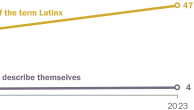As shown in Figure 10, language usage diverges between SOR Hispanics and white Hispanics. Among the native-born, 73 percent of SOR Hispanics were bilingual compared to 62 percent of white Hispanics.
While second generation adults (native-born of foreign-born parents) cannot be distinguished from the third and higher generations (native-born of native-born parents) in the 2000 Census, data from the National Survey of Latinos (NSL) indicate that white Hispanics are more often found in the third generation than SOR Hispanics. Among native-born white and SOR Latinos in the NSL, 45 percent of white Hispanics belonged to the second generation, while 55 percent belonged to third or higher generations. In contrast, 55 percent of SOR Hispanics belonged to the second generation, while 45 percent belonged to third or higher generations.

Another rough indicator of generational status is the probability of intermarriage. Estimates of intermarriage rates are 8 percent for foreign-born Hispanics, 32 percent for the second generation, and 57 percent for the third and higher generations (Edmonston, Lee, and Passel, 2002). Again, Census results on intermarriage for SOR Hispanics and white Hispanics are consistent with the idea that among the nativeborn, SOR Hispanics are more likely to be of the second rather than the third generation compared to white Hispanics.
For both foreign-born and native-born Hispanic male householders, the racial and ethnic identity of their spouse is most likely to be identical to their own.
For both foreign-born and native-born Hispanic male householders, the racial and ethnic identity of their spouse is most likely to be identical to their own (Table 7). This trend is more pronounced among foreign-born men. For example 88 percent of white Hispanic males are married to white Hispanic females.5 In terms of out-marriage, Hispanic males who identify as white have non-Hispanic wives more often than SOR Hispanic men.





